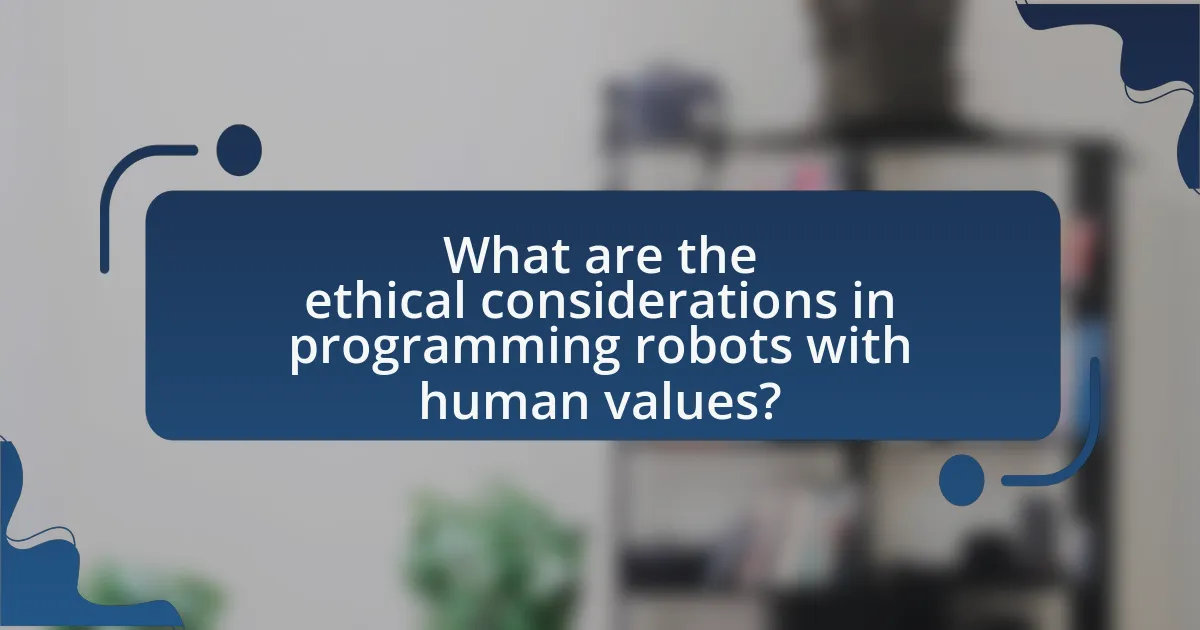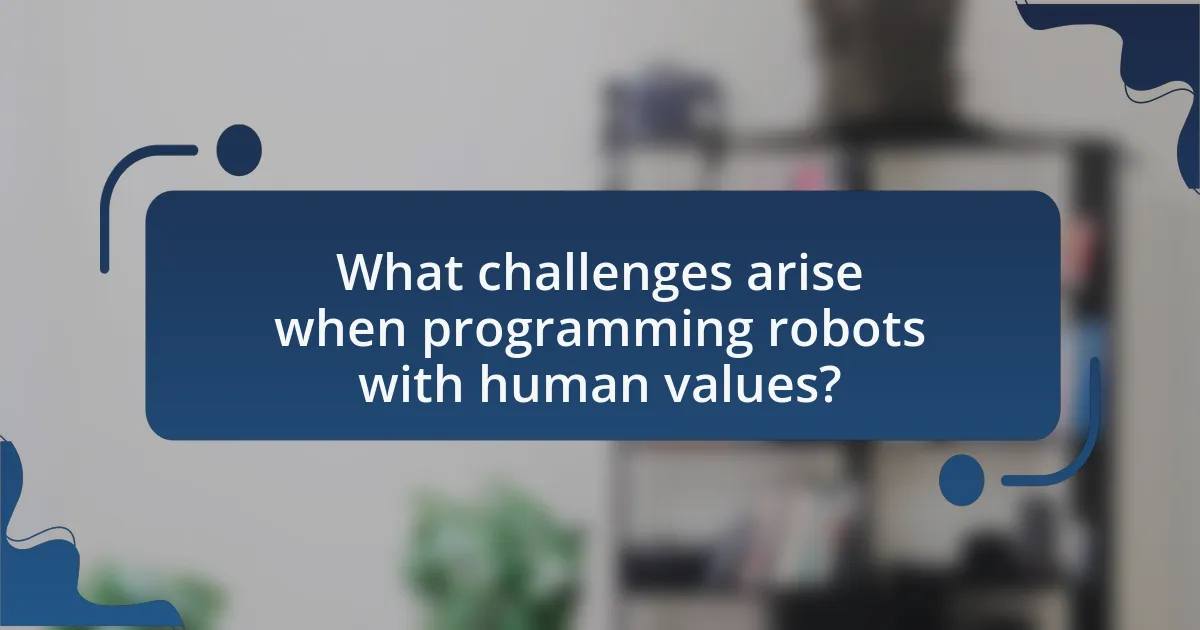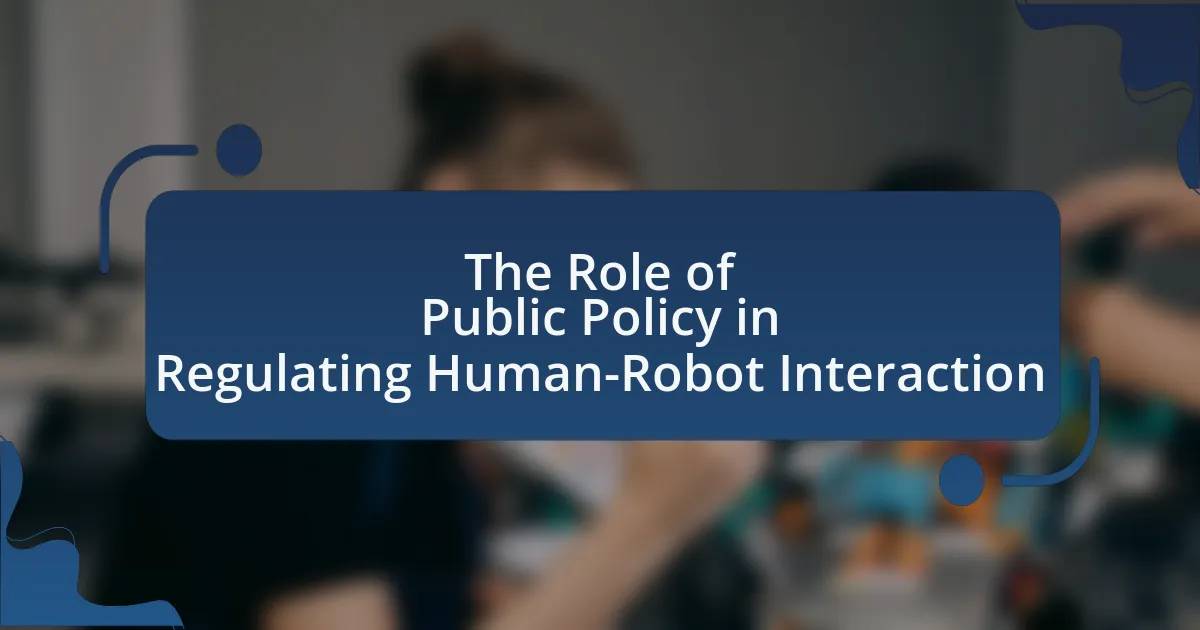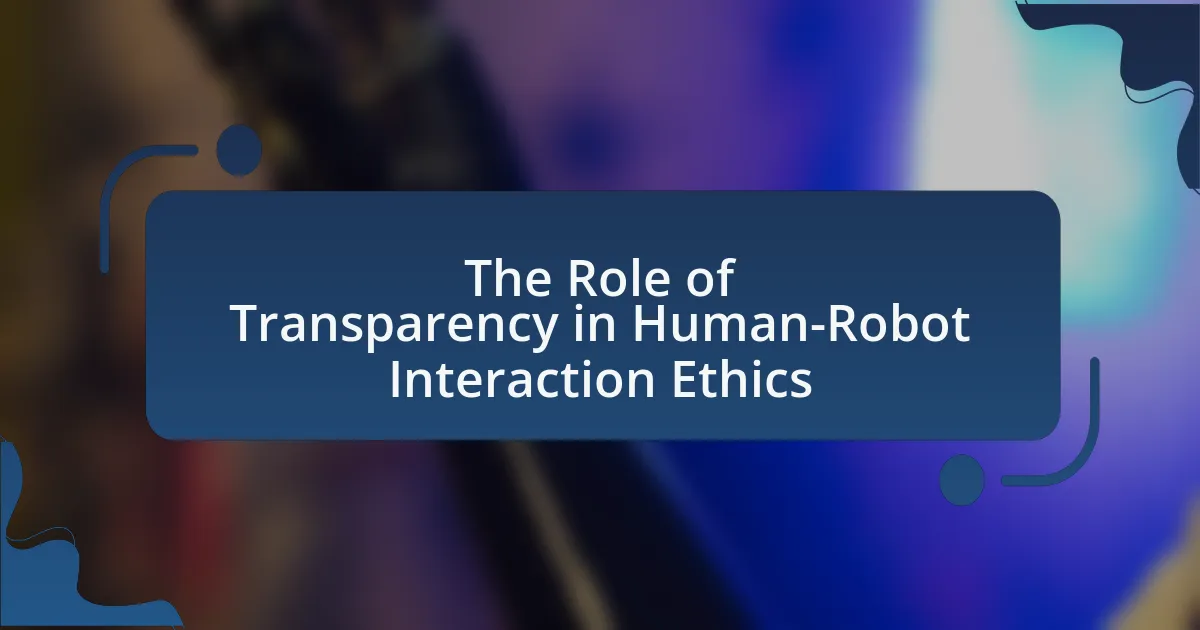The article focuses on the ethics of programming robots with human values, highlighting the critical ethical considerations involved in aligning robotic behavior with societal norms and moral principles. It discusses the importance of integrating human values to prevent bias, discrimination, and harmful outcomes, as well as the challenges developers face in translating complex human ethics into code. The article also examines existing ethical frameworks, the role of transparency and accountability, and the societal implications of autonomous decision-making by robots. Additionally, it addresses the influence of public perceptions and educational initiatives on the ethical standards in robotics, emphasizing best practices for developers in creating socially acceptable robotic systems.

What are the ethical considerations in programming robots with human values?
Programming robots with human values raises significant ethical considerations, primarily concerning the alignment of robotic behavior with societal norms and moral principles. These considerations include the potential for bias in value selection, the implications of decision-making autonomy, and the accountability for actions taken by robots. For instance, if a robot is programmed with biased human values, it may perpetuate discrimination or inequality, as evidenced by studies showing that algorithms can reflect and amplify societal biases (e.g., the research by ProPublica on predictive policing algorithms). Furthermore, the autonomy granted to robots in decision-making processes can lead to ethical dilemmas, particularly in life-and-death situations, such as autonomous vehicles making split-second decisions in accidents. Lastly, the question of accountability arises when robots cause harm; determining whether the responsibility lies with the programmer, the manufacturer, or the robot itself is a complex ethical issue that requires careful consideration.
Why is it important to integrate human values into robotics?
Integrating human values into robotics is crucial to ensure that robotic systems operate in ways that align with societal norms and ethical standards. This alignment helps prevent harmful outcomes, such as discrimination or invasion of privacy, which can arise from automated decision-making processes. For instance, research by the IEEE Global Initiative on Ethics of Autonomous and Intelligent Systems emphasizes the necessity of embedding ethical considerations into technology design to promote accountability and transparency. By prioritizing human values, robotics can enhance user trust and acceptance, ultimately leading to safer and more beneficial interactions between humans and machines.
What are the potential consequences of neglecting human values in robotics?
Neglecting human values in robotics can lead to significant ethical dilemmas and societal harm. When robots are programmed without consideration for human values, they may make decisions that prioritize efficiency over safety, resulting in potential harm to individuals or groups. For instance, autonomous vehicles lacking ethical programming could prioritize minimizing damage to their own structure over the safety of pedestrians, leading to fatal accidents. Additionally, neglecting human values can exacerbate issues of bias and discrimination, as algorithms may reflect and perpetuate existing societal inequalities, as evidenced by studies showing biased outcomes in facial recognition technologies. This disregard for human values can erode public trust in robotic systems, hindering their acceptance and integration into society.
How do human values influence robot behavior and decision-making?
Human values significantly influence robot behavior and decision-making by guiding the ethical frameworks within which robots operate. These values are integrated into algorithms and programming, shaping how robots interpret situations and respond to human interactions. For instance, robots programmed with values such as empathy and fairness are more likely to prioritize human well-being and equitable outcomes in their decisions. Research by the MIT Media Lab highlights that incorporating human values into AI systems can lead to more socially acceptable and trustworthy behaviors, as seen in robots designed for caregiving roles that prioritize patient comfort and safety. This alignment with human values ensures that robots act in ways that are consistent with societal norms and ethical standards.
What frameworks exist for ethical programming of robots?
Several frameworks exist for the ethical programming of robots, including the IEEE Global Initiative on Ethics of Autonomous and Intelligent Systems, the Asilomar AI Principles, and the European Commission’s Ethics Guidelines for Trustworthy AI. The IEEE framework provides a comprehensive set of guidelines aimed at ensuring that technology aligns with human values, emphasizing accountability and transparency. The Asilomar AI Principles focus on safety, transparency, and the long-term benefits of AI, advocating for the responsible development of intelligent systems. The European Commission’s guidelines outline key requirements for trustworthy AI, including human oversight, technical robustness, and respect for privacy. These frameworks collectively aim to guide the ethical development and deployment of robotic systems, ensuring they operate in ways that are beneficial and aligned with societal values.
How do different ethical theories apply to robotics?
Different ethical theories apply to robotics by providing frameworks for evaluating the moral implications of robotic actions and decisions. Utilitarianism, for instance, assesses the consequences of a robot’s actions, aiming to maximize overall happiness or minimize harm, which is crucial in scenarios like autonomous vehicles making split-second decisions. Deontological ethics focuses on adherence to rules and duties, guiding the programming of robots to follow strict ethical guidelines, such as not harming humans, as seen in Asimov’s laws of robotics. Virtue ethics emphasizes the character and intentions behind robotic actions, suggesting that robots should embody virtues like honesty and compassion, influencing their interactions with humans. These theories collectively inform the ethical programming of robots, ensuring they align with human values and societal norms.
What role do guidelines and standards play in ethical robot programming?
Guidelines and standards are essential in ethical robot programming as they establish a framework for responsible design and operation. These guidelines ensure that robots are programmed to prioritize human safety, privacy, and fairness, thereby aligning their functionalities with societal values. For instance, the IEEE Global Initiative on Ethics of Autonomous and Intelligent Systems provides a comprehensive set of principles aimed at promoting ethical considerations in technology development. By adhering to such standards, developers can mitigate risks associated with bias, discrimination, and unintended consequences, ultimately fostering trust in robotic systems.
How can we assess the effectiveness of human values in robots?
To assess the effectiveness of human values in robots, researchers can utilize a combination of behavioral evaluations, ethical frameworks, and user feedback mechanisms. Behavioral evaluations involve observing how robots respond to moral dilemmas or social interactions, which can reveal their alignment with human values. Ethical frameworks, such as utilitarianism or deontological ethics, provide structured guidelines for programming robots to prioritize certain values over others. User feedback mechanisms, including surveys and interviews, allow developers to gather insights on how well robots embody human values from the perspective of those interacting with them. These methods collectively ensure that the integration of human values in robotic systems is both practical and reflective of societal norms.
What metrics can be used to evaluate ethical behavior in robots?
Metrics to evaluate ethical behavior in robots include adherence to ethical guidelines, decision-making transparency, and the ability to minimize harm. Adherence to ethical guidelines can be assessed by measuring how well a robot follows established ethical frameworks, such as utilitarianism or deontological ethics. Decision-making transparency involves evaluating how clearly a robot can explain its actions and the reasoning behind them, which is crucial for accountability. The ability to minimize harm can be quantified by analyzing the outcomes of a robot’s actions in various scenarios, ensuring that it prioritizes safety and well-being. These metrics are supported by research indicating that ethical frameworks and transparency are essential for trust in robotic systems, as highlighted in studies like “Ethics of Artificial Intelligence and Robotics” by Vincent C. Müller.
How do user perceptions impact the assessment of robot ethics?
User perceptions significantly influence the assessment of robot ethics by shaping expectations and moral judgments regarding robotic behavior. When users perceive robots as capable of ethical reasoning, they are more likely to expect them to adhere to ethical standards, which can lead to increased trust and acceptance of robotic systems. Conversely, negative perceptions, such as viewing robots as mere tools or threats, can result in skepticism about their ethical implications and a reluctance to integrate them into society. Research indicates that user attitudes towards technology, including robots, are often informed by cultural, social, and personal experiences, which directly affect how ethical considerations are evaluated. For instance, a study by Lin et al. (2011) in “The Ethics of Autonomous Vehicles” highlights that public perception of autonomous systems is heavily influenced by perceived risks and benefits, demonstrating that user perceptions are crucial in shaping ethical assessments.

What challenges arise when programming robots with human values?
Programming robots with human values presents significant challenges, primarily due to the complexity and variability of human ethics. One major challenge is the difficulty in defining and encoding subjective human values into algorithms, as values can differ widely across cultures and individuals. For instance, a study by the MIT Media Lab highlights that ethical decisions can vary based on context, leading to inconsistencies in robot behavior when faced with moral dilemmas. Additionally, the challenge of ensuring that robots can adapt to evolving human values over time complicates programming efforts. This adaptability is crucial, as static programming may result in robots that become obsolete or misaligned with societal norms. Furthermore, there is the risk of unintended consequences, where robots may misinterpret or misapply human values, leading to harmful outcomes. These challenges underscore the need for ongoing research and dialogue in the field of robotics ethics.
What are the technical limitations in implementing human values in robots?
The technical limitations in implementing human values in robots include challenges in defining and quantifying human values, difficulties in programming complex ethical decision-making, and constraints in machine learning algorithms. Defining human values is inherently subjective, making it difficult to create a standardized framework that robots can follow. Additionally, ethical decision-making often requires context and nuance, which current programming techniques struggle to replicate. For instance, the Moral Machine experiment highlighted the complexity of moral dilemmas faced by autonomous vehicles, revealing that different cultures prioritize different values, complicating the programming process. Furthermore, machine learning algorithms may not adequately capture the intricacies of human values, as they rely on data that may not represent the full spectrum of human ethical considerations.
How do programming languages and algorithms affect ethical decision-making?
Programming languages and algorithms significantly influence ethical decision-making by determining how data is processed and decisions are made within automated systems. The design of algorithms can embed biases or ethical considerations, impacting outcomes in areas such as healthcare, criminal justice, and hiring practices. For instance, a study by ProPublica in 2016 revealed that an algorithm used in the criminal justice system was biased against African American defendants, leading to unfair sentencing recommendations. This illustrates how the choice of programming language and the structure of algorithms can perpetuate or mitigate ethical dilemmas, ultimately shaping societal norms and values.
What challenges do developers face in translating human values into code?
Developers face significant challenges in translating human values into code, primarily due to the complexity and variability of human ethics. The subjective nature of values means that what is considered ethical can differ widely among cultures, individuals, and contexts, making it difficult to create universally applicable algorithms. For instance, a study by the MIT Media Lab found that people have diverse opinions on moral dilemmas, indicating that a single coding approach may not satisfy all ethical perspectives. Additionally, developers must navigate the limitations of current technology, which often lacks the nuance required to interpret and implement complex human values accurately. This challenge is compounded by the potential for unintended consequences, where code designed to reflect certain values may inadvertently promote biases or harmful outcomes, as seen in various AI applications that have faced scrutiny for perpetuating stereotypes.
What societal implications stem from programming robots with human values?
Programming robots with human values can lead to significant societal implications, including ethical dilemmas, shifts in labor dynamics, and changes in interpersonal relationships. Ethical dilemmas arise when robots must make decisions that involve moral judgments, potentially leading to conflicts between programmed values and human expectations. For instance, autonomous vehicles programmed to prioritize passenger safety may face situations where they must choose between the safety of their occupants and that of pedestrians, raising questions about accountability and moral responsibility.
Shifts in labor dynamics occur as robots with human values may replace jobs traditionally held by humans, particularly in caregiving and service industries. A study by the McKinsey Global Institute estimates that up to 800 million jobs could be displaced by automation by 2030, necessitating a reevaluation of workforce skills and economic structures.
Changes in interpersonal relationships can manifest as humans may begin to form emotional attachments to robots programmed with empathy and social values, potentially altering social norms and expectations in human interactions. Research published in the journal “AI & Society” highlights that individuals often attribute human-like qualities to robots, which can influence their social behavior and emotional responses.
These implications underscore the need for careful consideration of the ethical frameworks guiding the programming of robots with human values, as they will significantly impact societal structures and human interactions.
How might robots with human values impact employment and labor markets?
Robots programmed with human values may lead to significant changes in employment and labor markets by enhancing collaboration between humans and machines, potentially creating new job categories while displacing some existing roles. For instance, as robots take over repetitive and hazardous tasks, human workers can focus on more complex, creative, and interpersonal roles, which are less likely to be automated. A study by the McKinsey Global Institute estimates that by 2030, automation could displace up to 30% of the global workforce, but it also suggests that new job creation in technology, healthcare, and green energy sectors could offset some of these losses. Additionally, robots with human values may improve workplace safety and productivity, leading to a more efficient labor market overall.
What ethical dilemmas arise from robots making autonomous decisions?
Robots making autonomous decisions present several ethical dilemmas, primarily concerning accountability, bias, and the potential for harm. Accountability issues arise because it becomes unclear who is responsible for a robot’s actions—whether it is the programmer, the manufacturer, or the robot itself. For instance, in cases where autonomous vehicles are involved in accidents, determining liability can be complex. Bias is another significant dilemma, as algorithms may reflect the prejudices of their creators, leading to unfair treatment of certain groups. A study by the MIT Media Lab found that facial recognition systems misidentified darker-skinned individuals at rates significantly higher than lighter-skinned individuals, highlighting the risks of biased programming. Lastly, the potential for harm is a critical concern; autonomous systems may make decisions that prioritize efficiency over human safety, as seen in military applications where drones make life-and-death decisions without human intervention. These dilemmas underscore the need for careful consideration of ethical frameworks in the development of autonomous technologies.
How can we ensure accountability in robots programmed with human values?
To ensure accountability in robots programmed with human values, it is essential to implement robust oversight mechanisms that include clear guidelines for ethical behavior, traceability of decisions, and human oversight. Establishing a framework that mandates transparency in the algorithms used allows for the evaluation of how decisions align with human values. For instance, the IEEE Global Initiative on Ethics of Autonomous and Intelligent Systems emphasizes the importance of accountability through standards that require documentation of decision-making processes. This ensures that actions taken by robots can be audited and assessed against ethical benchmarks, thereby reinforcing accountability.
What legal frameworks are necessary for robot accountability?
Legal frameworks necessary for robot accountability include liability laws, regulatory standards, and ethical guidelines. Liability laws must clearly define who is responsible for a robot’s actions, whether it be the manufacturer, programmer, or user, to ensure accountability in case of harm or malfunction. Regulatory standards should establish safety and operational protocols for robots, ensuring they adhere to human values and ethical considerations. Ethical guidelines must provide a framework for decision-making processes in robots, aligning their actions with societal norms and values. These frameworks are essential to address the complexities of robot interactions and their impact on human life, as evidenced by ongoing discussions in legal and technological circles regarding the implications of autonomous systems.
How can transparency in programming enhance accountability?
Transparency in programming enhances accountability by allowing stakeholders to understand the decision-making processes and algorithms that govern robotic behavior. When programming is transparent, it enables developers, users, and regulators to scrutinize the code and logic, ensuring that ethical standards are upheld. For instance, the implementation of open-source software in robotics allows for peer review, which can identify biases or errors in algorithms, thereby fostering responsible development practices. This scrutiny can lead to improved trust among users and the public, as they can verify that the programming aligns with human values and ethical considerations.

What future trends are emerging in the ethics of programming robots with human values?
Future trends in the ethics of programming robots with human values include the integration of diverse ethical frameworks, increased transparency in algorithmic decision-making, and the prioritization of human-centric design. The integration of diverse ethical frameworks, such as utilitarianism and deontological ethics, aims to create robots that can navigate complex moral dilemmas more effectively. Increased transparency in algorithmic decision-making is essential for building trust, as stakeholders demand clarity on how robots make ethical choices. Furthermore, prioritizing human-centric design ensures that robots align with societal values and cultural norms, reflecting a growing recognition of the importance of inclusivity in technology. These trends are supported by ongoing discussions in academic and industry circles, emphasizing the need for ethical guidelines that adapt to technological advancements.
How is artificial intelligence shaping the ethical landscape of robotics?
Artificial intelligence is shaping the ethical landscape of robotics by introducing complex decision-making capabilities that require ethical considerations in programming. As AI systems become more autonomous, they must navigate moral dilemmas, such as prioritizing human safety over efficiency, which raises questions about accountability and transparency in robotic actions. For instance, the development of self-driving cars has prompted discussions about the ethical implications of algorithms that determine how to respond in accident scenarios, highlighting the need for ethical frameworks that align with human values. Research by the IEEE Global Initiative on Ethics of Autonomous and Intelligent Systems emphasizes the importance of integrating ethical principles into AI design to ensure that robotic systems act in ways that are beneficial and just for society.
What advancements in AI could improve ethical programming practices?
Advancements in AI that could improve ethical programming practices include the development of explainable AI (XAI), which enhances transparency in decision-making processes. XAI allows developers and users to understand how AI systems arrive at conclusions, thereby fostering accountability and trust. Research indicates that systems designed with XAI principles can reduce biases and improve fairness in outcomes, as seen in studies like “Explainable Artificial Intelligence (XAI): Concepts, Taxonomies, Opportunities and Threats” by Adadi and Berrada, published in 2018. Additionally, incorporating ethical frameworks into AI training data can guide AI behavior towards human values, ensuring that ethical considerations are embedded in the programming process.
How do emerging technologies challenge existing ethical frameworks?
Emerging technologies challenge existing ethical frameworks by introducing complexities that traditional ethics cannot adequately address. For instance, artificial intelligence systems can make autonomous decisions that may conflict with established moral principles, such as fairness and accountability. The rapid advancement of technologies like machine learning and robotics raises questions about privacy, consent, and the potential for bias, which existing ethical guidelines often overlook. A notable example is the use of AI in hiring processes, where algorithms may inadvertently perpetuate discrimination, highlighting the inadequacy of current ethical standards to manage such scenarios effectively.
What role do public perceptions play in the future of ethical robotics?
Public perceptions significantly influence the future of ethical robotics by shaping the development, acceptance, and regulation of robotic technologies. As societal attitudes towards robots evolve, they directly impact how developers prioritize ethical considerations in design and functionality. For instance, a 2021 survey by the Pew Research Center found that 72% of Americans expressed concerns about robots making decisions that affect human lives, highlighting the importance of public trust in ethical robotics. This trust is crucial for the widespread adoption of robots in sensitive areas such as healthcare and law enforcement, where ethical implications are profound. Therefore, understanding and addressing public perceptions is essential for guiding the ethical programming of robots aligned with human values.
How can public engagement influence ethical standards in robotics?
Public engagement can significantly influence ethical standards in robotics by fostering dialogue between developers, policymakers, and the community. This interaction allows diverse perspectives to shape the ethical frameworks guiding robotic technology, ensuring they align with societal values. For instance, public forums and surveys can reveal community concerns about privacy, safety, and job displacement, which can then inform regulatory measures and design choices. Research conducted by the Pew Research Center indicates that 72% of Americans believe that ethical considerations should guide the development of AI and robotics, highlighting the importance of public input in shaping these standards.
What educational initiatives are necessary to promote ethical awareness in robotics?
Educational initiatives necessary to promote ethical awareness in robotics include integrating ethics courses into engineering and computer science curricula, fostering interdisciplinary collaboration, and implementing hands-on workshops that emphasize real-world ethical dilemmas. These initiatives ensure that future robotics professionals understand the societal implications of their work. For instance, universities like Stanford and MIT have developed programs that combine technical training with ethical discussions, highlighting the importance of responsible innovation. Research indicates that students exposed to ethical frameworks are more likely to consider the moral dimensions of their designs, as shown in studies published in the Journal of Engineering Education.
What best practices should developers follow when programming robots with human values?
Developers should prioritize transparency, accountability, and inclusivity when programming robots with human values. Transparency ensures that the decision-making processes of robots are understandable to users, fostering trust. Accountability involves establishing clear guidelines for the ethical use of robots, ensuring that developers are responsible for their creations. Inclusivity requires considering diverse perspectives and values during the design process, which can be supported by user feedback and interdisciplinary collaboration. Research indicates that these practices can lead to more ethical and socially acceptable robotic systems, as highlighted in the IEEE Global Initiative on Ethics of Autonomous and Intelligent Systems.





